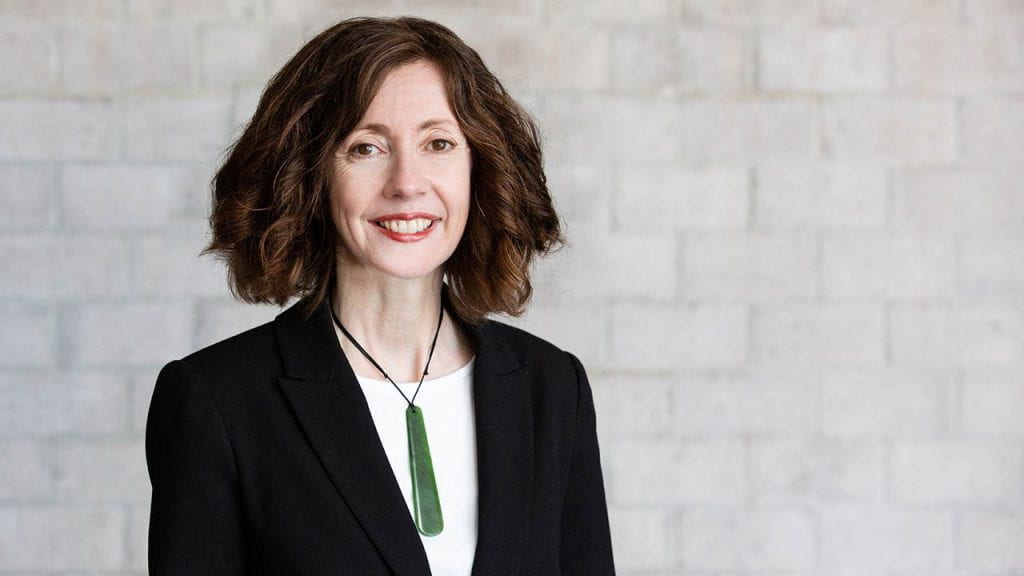Prof. Deidre Brown – Ngā Toi Mōrehu: The Arrival, Survival and Revival of Māori Art and Architecture
If you want to change the world, then you might want to become an academic, suggests Professor Deidre Brown (Ngāpuhi, Ngāti Kahu).
Prof. Brown’s Inaugural Professorial Lecture was delivered on 19 November 2019 at the University of Auckland.

‘Toitū te whenua, toitū te tikanga, ka ora ngā toi’. ‘When we hold fast to our land and values, our arts and architecture flourish’. But what happens to Māori art and architecture when whenua (land) and tikanga (values) are under threat? How have these practices survived, changed, recovered and, in turn, reclaimed land and maintained values over the past two centuries?
The First Māori Professor of Architecture
Professor Brown is the first Māori professor of architecture in the world and one of the only professors of architecture of Indigenous descent. As her first year, in a five year term, as Head of the School of Architecture and Planning at the University of Auckland drew to a close in November 2019, Professor Brown gave her inaugural lecture, “Nga Toi Morehu: The Arrival, Survival and Revival of Maori Art and Architecture”, which was warmly received by a large group of colleagues, students, whanau and friends.
Professor Brown reflected on 25 years in which she has, so far, explored how whenua (land) and tikanga (values) manifest in our buildings and objects, in periods of strength and in times when those principles are under threat.
She will acknowledged the people, places and events that have shaped her academic career and she encouraged young people and aspiring researchers to consider an academic future by preferably getting their PhDs earlier rather than later.
“You need to go through the PhD experience to get the license to be an academic. It’s a test of your mettle, and your understanding of high-level research, but it’s also a chance to spend at least three years considering one important question. You’ll never have another opportunity like that in your life.”
If you want to have a significant effect, and this is important for me as a Māori academic, teaching is the way to go.” – Professor Deidre Brown
All evidence suggests Professor Brown is the first Indigenous woman to lead a School of Architecture and Planning in the world, and she’s enjoying it. “It’s a privilege to be able to pass on your knowledge, and what you’ve learned from other people.”
It’s also, she says, a way to shape the built environment of the future. “The School is the major training ground for architects and planners in the country, so what we teach will affect the shape of Auckland for the next century.
“You can go out as an architect and change the world one building at a time but as an academic, you’re changing it with 100 architectural graduates a year. If you want to have a significant effect, and this is important for me as a Māori academic, teaching is the way to go.”
Professor Brown’s teaching, supervisory and research interests are in the fields of Māori and Pacific architectural and art history and indigenous design. Her book, Māori Architecture; from fale to wharenui and beyond (2009) was the result of 15 years of research, and the first book on the history of Māori architecture.
The buildings and objects of the past reveal much about the past. Her research is primarily focussed on the early 19th century to the middle of the 20th century, and “if you don’t understand what happened in New Zealand in the 19th century you’ll never understand this country” she says.
Consider Auckland, for example. “It is essentially a 19th century city,” she says. “A lot of the housing stock is based on pre-war ideas of what a building should be, the layout of the city is based on Victorian ideas about how a city should be laid out, even in the Victorian names of the streets. We might think of it as the modern city in the country, but it still has this Victorian footprint.
The built environment “teaches us about history, about race relations, about the meaning of the Treaty, how we solved issues or didn’t. You can’t move forward without understanding the past.”
Professor Brown has now authored or co-authored eight books, and her ninth Toi Te Mana: A history of indigenous art is due to be published at the end of 2020. The book is co-authored with the late Professor Jonathan Mane-Wheoki and Dr Ngarino Ellis of the Faculty of Arts.
“It’s a big book,” she says, with up to 500 images and 200,000 words which she jokes that for her and Dr Ellis writing a PhD each. “I don’t know we would have agreed to do it, if we knew that in before we started!”
